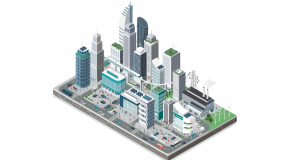Main takeaways
- A universal definition of urban liveability is bound to be elusive. Judgements about a city’s liveability can be subjective, reflecting residents’ personal appreciation for various social, economic and environmental goods.
- Urban planning demands co-ordinated action. Policymakers can explore tools for bringing diverse stakeholders to agree on policies and regulations and contribute to beneficial outcomes.
- Forward-thinking urban officials are striving to make cities embody the virtues of villages. “Fifteen-minute cities” with qualities like walkability and strong social bonds can foster strong innovation ecosystems.
- Better urban design means putting people first. Public consultation can contribute to the development of cities where people can live longer and better lives.
In January 2024, heads of state, business leaders, thinkers and investors gathered in Davos, Switzerland, for the annual meeting of the World Economic Forum.
On January 16th Economist Impact assembled experts on urban planning and development, policymaking and social science for a panel discussion on the future of cities. According to the United Nations Conference on Trade and Development (UNCTAD), more than 55% of the global population already lives in cities. That proportion is projected to grow to almost 70% by 2050. Cities are crucibles of innovation and social progress. “Cognitive cities”, where data-driven intelligence informs everyday life, hold special promise. But if poorly designed and managed, cities risk exacerbating climate change, underperforming economically and fuelling political instability.
Sponsored by NEOM, a high-tech development planned for Saudi Arabia’s north-west coast, and moderated by Jonathan Birdwell, global head of policy and insights at Economist Impact, the panel explored the concepts of liveability, sustainability and resilience in the urban context.
Liveability in practice
Many, if not most, of the world’s cities have grown in a makeshift and unplanned way. They have accrued land and attracted people in sporadic waves. When blueprints have been present, they have typically been artefacts of local politics, environmental features and cultural values.
Mr Birdwell opened the discussion by asking whether, despite this history, there is a definition of “liveability” that cities everywhere can aspire to.
Jeff Risom, the chief innovation officer at Gehl People, a Copenhagen-based urban design consultancy, pointed out that the Scandinavian model is often advanced as a template. Cities like Copenhagen offer plentiful public spaces, short commuting times and high-quality public services. But he argued that a dynamic view of liveability would not seek to impose the realities of one part of the world on any other, and should instead embrace local norms and tastes. Mr Risom proposed the notion of a “net promoter score” for cities as an approximate measure of liveability. Net promoter scores are common in the digital realm, measuring the quality of tools and services by the enthusiasm with which users extol them to others. Mr Risom argued that to the extent those living in a city would recommend it on their own subjective judgement, it might be considered liveable.
Kent Larson, director of the city science group at the MIT Media Lab, is also wary of universal definitions of liveability. While various indices, including the Economist Intelligence Unit’s Global Liveability Index, capture different nuances of the concept, he said the liveability of a city is ultimately personal to its inhabitants, reflecting an interplay of social, economic and environmental factors. For example, are social ties strong and supportive? Are there enough job opportunities? Is the air clean? Are people happy?
THE LINE’s executive director of development at NEOM Mark Dickinson, explained that the project’s approach to liveability is to maximise “connectivity, community and convenience” through a focus on better architecture, design and infrastructure. As a region being developed from the ground up, NEOM has an opportunity to design for liveability from the outset. By contrast, existing cities around the world have brought billions of people into geographical proximity but without the ability to design for maximal connectivity and liveability from a “blank slate”.
The role of policymaking
The growth of liveable, sustainable and resilient cities will not happen by accident. Adopting new approaches to urban planning demands co-ordinated action at the local, national and even international levels.
Unfortunately, securing such alignment isn’t easy.
Chantal-Line Carpentier, UNCTAD’s head of trade, environment, climate change and sustainable development, stressed the complexity of getting diverse stakeholders with conflicting priorities to agree on untested policies and regulations, especially when funding is limited. But, she argued, doing so is essential if the opportunity to build better, more liveable cities is to be realised.
Where common ground can be found, policymakers have at their disposal many powerful tools for encouraging developers, investors and communities to be more progressive. For example, Ms Carpentier highlighted ways that financing for urbanisation projects can be made dependent on recipients’ accounting for social, aesthetic or environmental outcomes. She noted the recent United Nations (UN) resolution on the social and solidarity economy, which is intended to help policymakers within UN member states support socially oriented entrepreneurs, helping to unlock innovations and ideas that can boost the development of cities, including their sustainability and resilience.
City planners commonly face an apparent trade-off between long-term goods and short-term expedience. Mr Dickinson described this as “politics getting in the way of policy”. The result is usually suboptimal outcomes for individuals, communities and the environment.
Creating urban ecosystems
Many cities around the world evolved as collections of interconnected villages. Separate communities became integrated over time and eventually meshed into coherent wholes.
Mr Larson argued that the most enlightened urban officials are aiming to return to something like that condition. Villages exemplify many of the virtues that planners claim to strive for: strong social bonds, walkability, local supply chains, open spaces and safe neighbourhoods. In various places, city planners have invested in infrastructure and services that enable urban daily life to resemble village life more closely. Proponents of these “15-minute cities” believe they will generally be better places to live, but only if city planners can ensure neighbourhoods maintain their distinctive characteristics while facilitating mobility and distributing services more equally between areas.
The concept of urban villages leads to the related idea of cities as “ecosystems”. Cities give innovators and entrepreneurs the resources they need to generate and implement their ideas, including capital, skilled workers, vast quantities of data and plenty of potential customers. Offering a platform for collaboration between innovators and entrepreneurs is one sign of a successful city. Ms Carpentier explained, though, that many cities fall short of the ideal by failing to actively promote this sort of activity. She suggested that forward-thinking cities should market themselves as “innovation havens” with policies that support and incentivise city-focused innovation. Mr Risom pointed out how examples of so-called “bureaucracy-free zones” have made it easier for social enterprises to register, get off the ground and ultimately have a positive effect on their urban surroundings.
The future of living
Mr Birdwell concluded the session by asking about the future of urban living given pressures from climate change and population growth.
A theme throughout the discussion had been that better urban design means putting people first. Mr Risom understood that idea in terms of the health of individuals and communities. Wanting to live longer and better lives is the essential motivation for most people to build and inhabit cities in the first place. The most successful future cities will make this possible.
Data and technology are already playing a growing role in policymaking, urban design, construction and social innovation. But as cities seek to adapt to the challenges of the 21st century and beyond, the panel agreed that those managing our urban environments must truly listen to the people who live there about what they want. While this can be done through artificial intelligence, big data and the internet of things, old-fashioned methods such as community consultation and public deliberation will remain vital.
The discussion closed with the idea that for urban change to be sustainable, it must maximise buy-in from those affected. The best way to do that is to create conditions of trust by putting the needs and hopes of ordinary people at the centre. Achieving this is perhaps the most important goal of the next generation of urban planners, designers and policy-makers.
Economist Impact will publish a series of articles throughout the year on reimaging local ecosystems to support people, planet and prosperity.




